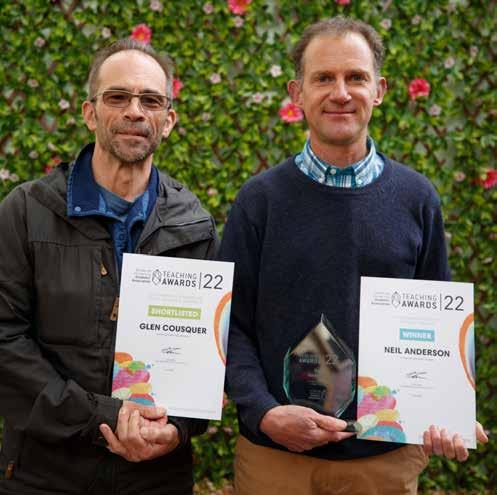
9 minute read
Oct Enzyme therapy shows promise for childhood dementia
by thedickvet
Infection and Immunity
Enzyme therapy shows promise for childhood dementia
Advertisement
Studies led by Washington University School of Medicine and the Roslin Institute into Batten Disease, a rare nervous system disorder that causes dementia and early death in children, have highlighted a possible treatment.
Regular infusions of a key enzyme that is deficient in children with infantile Batten disease, also called CLN1 disease, led to improvements in mice and sheep with an equivalent genetic disorder.
The findings could inform development of effective treatments for children with the disease, which can lead to loss of vision, cognitive and movement dysfunction, seizures and early death.
Scientists studied the effect of administering doses of the enzyme, known as PPT1, in mice and sheep with the same faulty gene that gives rise to the disease in children.
Monthly doses of the PPT1 enzyme to the brains of mice led to improved motor function, reduced signs of disease in brain cells, and reduced loss of brain matter over six months of treatment.
The research team first verified the dosage of enzyme and route of administration needed to have a beneficial effect in mice, and extrapolated their findings to determine effective enzyme infusion treatments for the affected sheep.
This critical step demonstrated that treatments which are promising in mice can be scaled up to have a similar positive treatment effect in a much larger brain.
Their study built on a similar approach for a different form of Batten disease, known as CLN2, which has led to a therapy called cerliponase alfa or Brineura. This has been approved by the NHS following successful clinical trials in a collaboration between centres around the world.
The latest study using mice and sheep has enabled insights into the effect of the therapy by testing basic principles in mice then refining them in a mammal whose brain size and complexity is comparable to that of children. The research team hope to conduct further studies to refine effective timings and dosage of enzyme replacement therapy, to move towards an effective treatment for this devastating childhood disorder.
Batten disease, one of several conditions known as lysosomal storage disorders, is an umbrella term for a group of neurodegenerative conditions caused by genetic mutations that affect cells’ waste disposal and recycling system.
These conditions can present at varying stages of childhood, depending on which gene is deficient. The PPT1-deficient CLN1 form of the disease develops in early childhood, progresses rapidly and there is currently no therapy available.
The Roslin team developed a sheep model for this disorder using the genome editing technology CRISPR/Cas9, so that therapeutic studies such as this could be done.
This enabled researchers to better understand the mechanisms underpinning progression of the disease, and to assess novel methods of managing the condition. The animals show many hallmarks of the disease in children, from signs of disease in cells through to changes in the size of the brain.
The study was published in the Journal of Clinical Investigation. This work was funded by the US National Institutes of Health, including an SBIR grant to Collaborations Pharmaceuticals, and the Haley’s Heroes Foundation.
This study could only have been done by a collaborative research team. Such work is a key step towards everyone’s ultimate goal of safely carrying out clinical tests of potential treatments in children affected by this devastating condition. Through studies in sheep, we gain invaluable insights into the progression of this condition which can guide our work towards developing an effective therapy.
Gene editing plus vaccines could eradicate disease
PRRS could be eliminated in less than three years with optimal distribution and effective vaccines, research led by the Roslin Institute suggests. Some livestock diseases could potentially be eradicated by introducing a proportion of animals that are genetically resistant to disease due to gene editing into some vaccinated herds. Gene-edited pigs resistant to disease would be introduced into breeding programmes and over generations, pigs would become genetically resistant to disease.
Eliminating disease on a national scale would be difficult to achieve using gene editing or vaccination alone, but it would be possible by combining the two approaches, computational models predict. Having 10 per cent of genetically resistant animals in a fraction of herds may eradicate disease in three to six years.
Findings from the study, which focused on Porcine Reproductive and Respiratory Syndrome (PRRS), could help eradicate this deadly disease, which costs the pig industry more than £1.75 billion per year in the US and Europe alone.
Gene-edited pigs that are resistant to PRRS have been produced at the Roslin Institute and are the subject of ongoing collaborative research.
The study was a collaboration between the Roslin Institute and agribusiness consultants AbacusBio.

Diseases in spotlight at One Health workshop
The challenge presented by emerging zoonotic diseases, and how best to model and control them, was the focus of an online workshop held in February and involving researchers from Scotland and China.
The event, involving the Global Academy of Agriculture and Food Security, the University of Edinburgh’s Global Health Academy and Shanghai Jiao Tong University, was supported by the British Council and National Natural Science Foundation of China, and titled ‘One health: surveillance and early warning for zoonoses’.
Talks spanned contributions of One Health approaches to sustainable development, advances in surveillance and response to zoonoses. Participants also considered the challenges of both emerging and endemic zoonoses, opportunities afforded by developments in technologies such as genomics, and modelling for pandemic preparedness.

Genetic analysis key to understanding Legionella risk
Routine sampling of water supplies and genomic sequencing of Legionella bacteria – determining its entire genetic makeup - could play a key role in identifying the source of Legionnaires’ disease outbreaks, research led by the Roslin Institute suggests.
The measures could also inform public health efforts to limit the spread of infection, according to a genomic study of the Legionella bacteria that causes the disease. Improved testing is crucial, researchers say, because the disease – a severe form of pneumonia – is contracted by inhaling the bacteria in aerosols – tiny droplets - of contaminated water.
Outbreaks are often linked to water systems in hotels, cruise ships and hospitals, and also within the community.
A team from the Roslin Institute and the University of Glasgow, Public Health Scotland and the Scottish Legionella Reference Laboratory compared the genomes, or genetic codes, of more than 3,000 Legionella bacteria samples found in patients and in water sources from Scotland and around the world.
The results revealed a new level of detail and fresh insights into the characteristics of Legionella bacteria and its transmission in Scotland.
From analysis of the genetic code, researchers found that Legionella infections linked to people travelling were often closely related to other variants from the same UK or international destination.
The analysis found that nearly one-third of infections in Scotland acquired in the community - not hospital or travel associated - were caused by a single variant. The team say this variant should be closely monitored.
Distinct variants of the bacteria were found in some hospitals over a long period of time – up to 17 years in some instances - which suggests that the bacteria persisted or were repeatedly introduced into hospital water systems.
The team also found that there had been no reported cases of Legionnaires’ disease in any Scottish hospital in the past 10 years. This is likely due to effectiveness of new control measures introduced during this time, experts say.
This work has been funded by the Chief Scientist Office, UKRI and Wellcome.

Genetic finding could help beat fatal cattle infection
Akey region of DNA has been identified that enables some cattle to survive a potentially devastating infection, raising the prospect of breeding livestock that do not succumb to the disease.
Researchers from the Centre for Tropical Livestock Genetics and Health (CTLGH), Roslin Institute, the International Livestock Research Institute (ILRI) and the University of Glasgow sought to understand whether regions of the cattle genome passed on between generations might equip some animals to survive infection with East Coast fever.
Genetic analysis of Boran cattle – an East African breed in which some animals can tolerate the disease – enabled the team to identify a region of DNA that may have a key role in preventing deadly infection. The results suggest a gene in the region may help to prevent the uncontrolled production of infected cells and reduce the risk of an animal becoming seriously ill or dying.
The outcome suggests that breeding cattle which carry the key genetic region, or developing cattle whose DNA is edited to carry the necessary genetic signature, may increase the tolerance to East Coast fever in imported cattle across Africa.
The discovery could help efforts to target East Coast fever, or theileriosis, which kills one million animals each year and costs farmers US$600m, largely affecting smallholders in sub-Saharan Africa. It could allow farmers in affected regions of Africa to keep non-native breeds with higher productivity, so long as they carry the necessary genomic signature to tolerate the disease.
The study, published in PLOS Genetics, was funded by the Bill & Melinda Gates Foundation and UK Foreign, Commonwealth and Development Office (FCDO) and supported by CGIAR and the Biotechnology and Biological Sciences Research Council, part of UK Research and Innovation.
The discovery of genes that enable cattle to survive infection with East Coast fever offers a route to introduce this beneficial DNA to non-native breeds, enabling reduced disease incidence and increased productivity, which would be of benefit to millions of rural smallholder farmers in Africa.
Stem cell approach to aid study of pig infections
Astudy led by scientists from the Roslin Institute suggests that a new method of producing immune cells from stem cells for research into pig infections is more affordable, practical and ethical than standard approaches.
Our scientists produced a type of immune cell - called macrophages - from pig stem cells, through a protocol adapted from a method used for mouse and human cells. They observed they had similar features to macrophages used in existing procedures, and served as targets for infection by key pig infections, such as Salmonella and the viruses that cause African swine fever and porcine reproductive and respiratory syndrome.
Investigations using the technique will benefit from access to an unlimited number of macrophages, which are easy to manipulate and can be infected by viruses and bacteria for a range of studies. The method reduces the need for animals in research and is less costly than conventional procedures, which use macrophages extracted from slaughtered animals and require continuous replacement.
Work conducted using the approach will be critical for devising effective strategies to combat important diseases such as African swine fever, and improve healthy, ethical livestock farming. For instance, the technique could be used to produce virus for the development of live vaccines.
Stem cell-derived macrophages can also be gene edited for targeted studies of the role of genetics in infections, for biotechnology applications, and to generate bespoke engineered cells for experiments.




